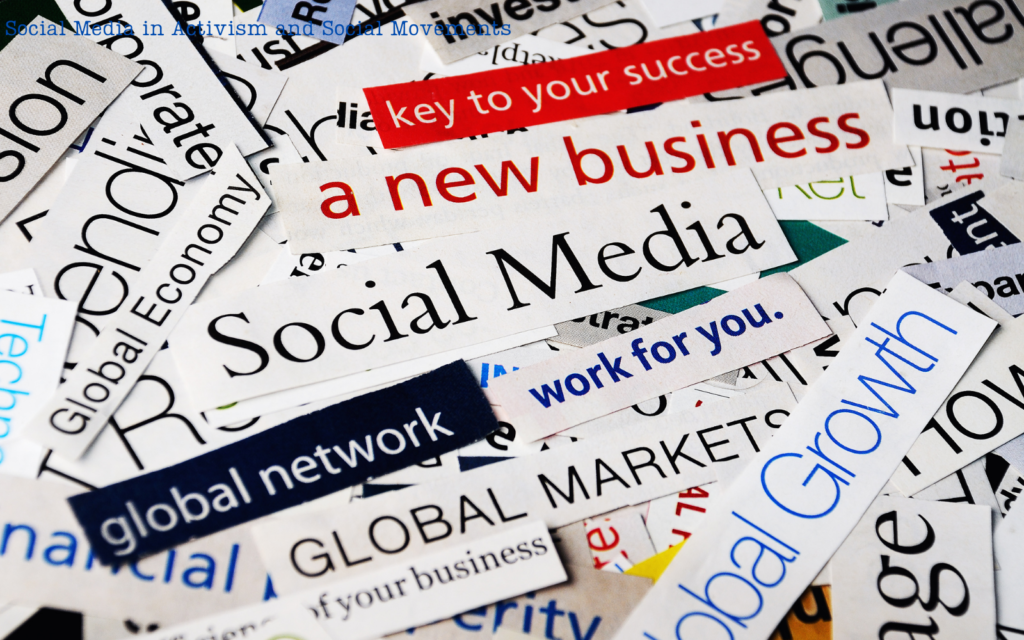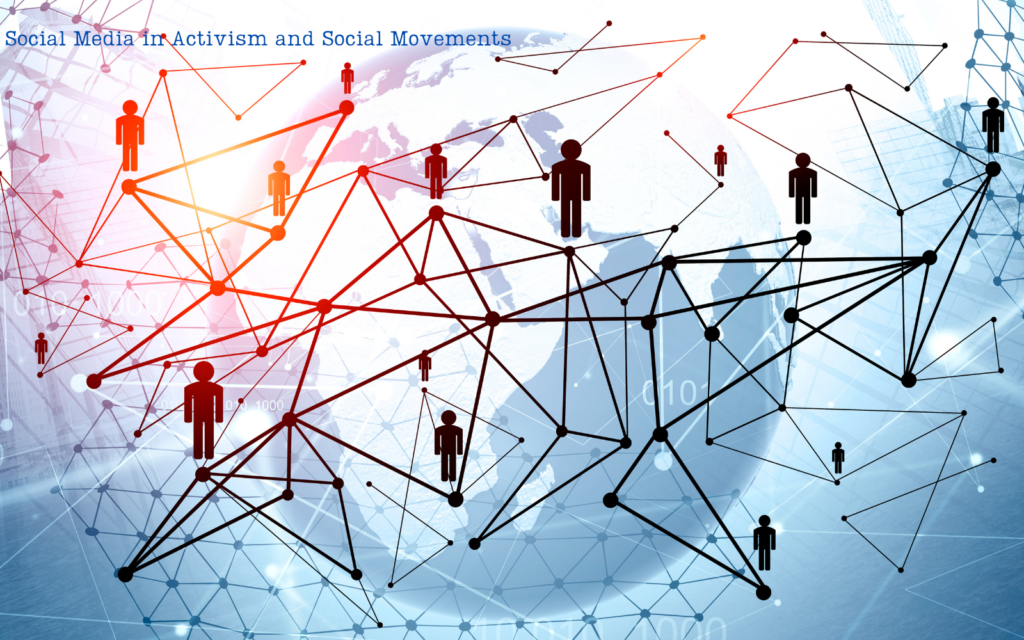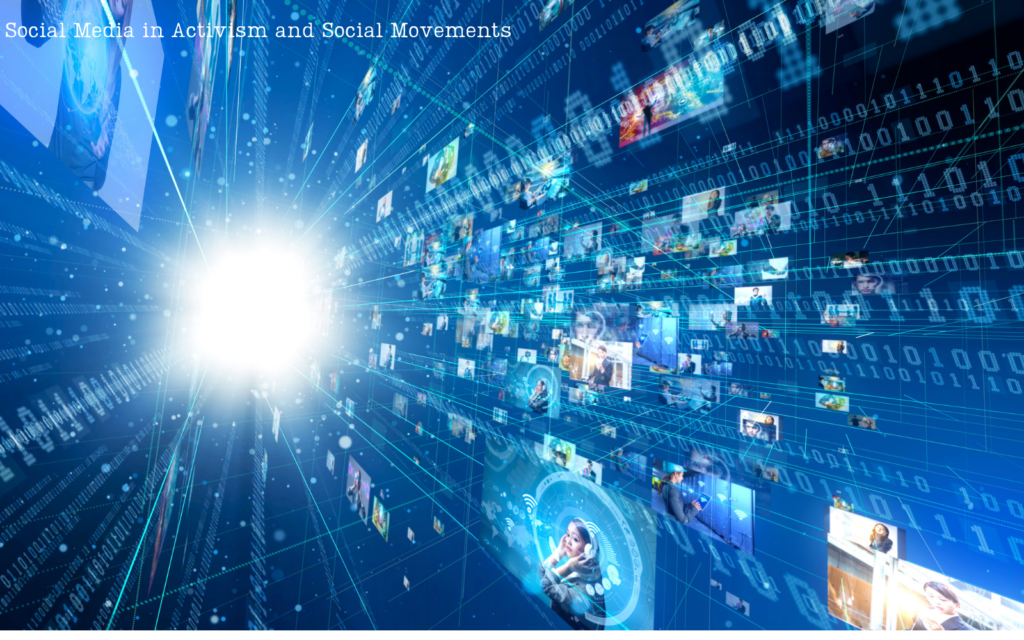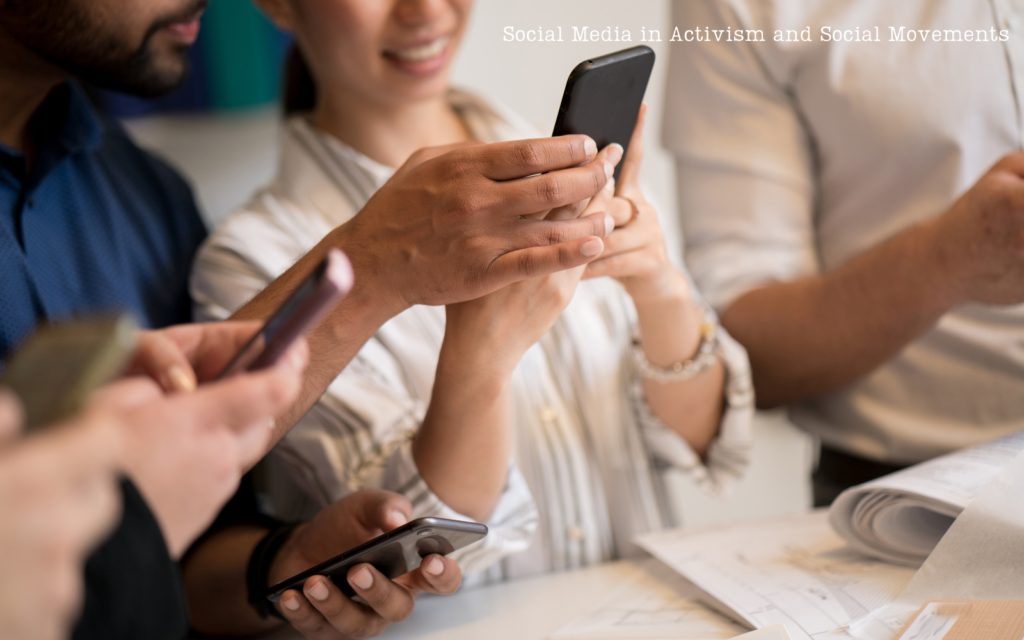Introduction: The Role of Social Media in Activism and Social Movements

Today, social media is a major tool for activism and social movements. It allows people and groups to raise awareness, rally supporters, and alter society globally.
Social media spreads information quickly, reaching a wide audience in seconds. They may now reach people from diverse backgrounds and locations with their messages, stories, and calls to action. Twitter, Facebook, and Instagram have disseminated #BlackLivesMatter, #MeToo, and #FridaysForFuture, raising awareness of racial injustice, gender inequity, and climate change.
Ability to interact directly with supporters and opponents is crucial. Social media allows activists to discuss, debate, and share ideas with a variety of stakeholders in real time. This can unite like-minded people and confront opposing views.
Social media also helps organize rallies, demonstrations, and other direct action. Facebook events and Twitter hashtags have rallied supporters, planned logistics, and provided real-time updates. This helped mobilize large-scale movements like the 2011 Arab Spring and 2019 Hong Kong pro-democracy protests.
In Conclusion, Social media amplifies voices, promotes dialogue, and spurs action in activism and social movements. It has changed internet social justice advocacy, notwithstanding its drawbacks.
Table of Contents
Rapid dissemination of information:
Activism and social movements depend on social media to quickly spread messages, stories, and calls to action. Consider these crucial points:

Reaching a global audience:
Twitter, Facebook, and Instagram have millions of users. These platforms allow activists to share their tales with a worldwide audience. This expands social justice knowledge and influence.
Virality:
Social media material may spread rapidly and massively online. This can quickly spread a movement and raise awareness of vital concerns. Virality may help activists start conversations, encourage action, and alter society.
Engagement:
Likes, shares, comments, and hashtags promote social media engagement. This lets activists communicate with their audience, generate community support, and make supporters feel included. Activists can build a loyal following by encouraging interaction.
Targeted messaging:
Social media algorithms let campaigners reach certain demographics, interests, and locations. This enables for customized communication techniques that appeal to different audience segments. Activists can address their audience’s worries and experiences to increase engagement and action
Real-time updates:
Social media lets activists publish developments, updates, and urgent calls to action. This speed enables for quick responses to events and emergencies, mobilizing support and resources when needed. Social media helps activists engage their followers and create a sense of urgency and momentum.
In conclusion, activism and social movements use social media to quickly share messages, stories, and calls to action worldwide. Social media platforms’ reach, virality, engagement, tailored messaging, and real-time updates can help activists raise awareness and influence society.
Engagement with supporters and opponents:
Real-time social media contact has changed how activists establish solidarity, confront opposing views, and communicate with their audience.
Consider these crucial points:
Dialogue and engagement:
Social media allows activists to interact with supporters, adversaries, and followers. This direct communication allows activists to share information, answer inquiries, and discuss important social issues. Dialogue helps activists humanize their cause, dispel myths, and connect with their audience.
Building solidarity:
Activists can connect with like-minded people, organizations, and communities across borders on social media. Sharing stories, experiences, and resources helps activists unite supporters. A shared purpose and belonging can energize the movement, inspire action, and maintain momentum.
Challenging opposing viewpoints:
Activists can question and oppose opposing perspectives, misinformation, and damaging myths on social media in real time. By engaging with critics, skeptics, and others with different ideas, activists can share evidence, suggest alternatives, and effectively advocate for their cause. This can extend the debate, improve awareness, and encourage critical thinking.
Organizing debates and discussions:
Social media can help activists arrange live debates, panel discussions, and virtual town halls on key social justice issues. These events allow for deep discussions, various viewpoints, and productive brainstorming. Through such activities, activists can promote intellectual curiosity, mutual respect, and constructive conversation within the movement.
Amplifying marginalized voices:
Social media empowers underprivileged people and communities to tell their stories and oppose oppression. Social media may help activists raise awareness of marginalized groups and advocate for their rights and dignity.
In conclusion, real-time social media contact helps activists establish solidarity, debate opposing views, and elevate marginalized voices in activism and social movements. Social media allows activists to build a more inclusive, dynamic, and effective movement that changes society.
Organizing and coordinating protests:
Facebook events and Twitter hashtags have changed how activists gather supporters, coordinate logistics, and inform supporters for protests and rallies.
Consider these crucial points:
Mobilizing supporters:
Social media allows campaigners to organize supporters for critical causes. Facebook events, Twitter campaigns, and Instagram stories can help activists promote protests, demonstrations, and other advocacy actions. These sites help activists spread awareness and build event momentum.
Planning logistics:
Communication and coordination among activists makes protest and demonstration planning easier on social media. Facebook events let organizers exchange event details, schedules, meeting spots, and logistics with participants. This ensures easy coordination, safety, and community among attendees.
Communicating updates:
Social media allows activists to disseminate protest and demonstration updates, developments, and calls to action in real time. Using Twitter hashtags, Facebook postings, or Instagram stories, activists can update event locations, plans, and urgent support requests. This keeps participants informed, involved, and sensitive to movement demands.

Crowd engagement:
Social media lets campaigners interact with protesters live. Facebook Live and Instagram Live allow activists to livestream speeches, concerts, and actions. This participatory strategy may excite, unite, and recruit virtual supporters.
Facilitating networking and collaboration:
Social media facilitates networking and collaboration among social movement individuals, organizations, and communities. Twitter lets activists share resources, ideas, and coordinate solidarity initiatives with like-minded people. Collaboration across sectors, increased impact, and social change movement strength are enhanced by this networking
In conclusion, Facebook events and Twitter hashtags help activists and social movements mobilize supporters, coordinate logistics, and update supporters for protests and demonstrations. Social media allows activists to organize events, engage participants, and inspire collective action for social justice.
Global reach:
Social media has helped #BlackLivesMatter and Fridays For Future spread globally to an unprecedented extent.
Consider these crucial points:
Global reach:
Twitter, Facebook, and Instagram allow activists to communicate with people and organizations worldwide. Using and creating viral content, activists may reach a diverse audience of supporters, advocates, and allies across borders. Movements get international attention and support with this global reach.
Cross-cultural exchange:
Social media encourages activists from different backgrounds and areas to communicate. Sharing experiences, viewpoints, and social change tactics is possible. This flow of ideas and knowledge may strengthen movements, spark innovation, and foster solidarity among activists working toward global goals.
Solidarity and support:
Social media allows activists to show solidarity and support for movements in other nations suffering comparable struggles. Actively sharing information, tools, and messages of solidarity helps activists connect with people and communities worldwide. This global network of support strengthens movements, maintains momentum, and unites social justice groups
Amplifying marginalized voices:
Social media allows underrepresented voices and communities to share their tales with the world. Social media may help activists raise awareness of inequality, injustice, and discrimination by elevating marginalized voices. Amplification of underrepresented voices raises awareness, empathy, and global support for marginalized communities.
International solidarity actions:
Social media lets activists organize international solidarity campaigns for other movements. Hashtags, social media challenges, and online petitions can raise awareness, pressure decision-makers, and support activists confronting repression or injustice. Global solidarity advances social justice causes across boundaries, as shown by this deed.
In conclusion, social media helps movements spread globally and fosters cross-cultural solidarity and support. Using social media’s worldwide reach, connectedness, and amplification, activists may organize, exchange resources, and collaborate internationally to solve social justice concerns and alter society.
Amplifying voices:
Marginalized groups can use social media to convey their stories and increase awareness of crucial activism and social movement concerns.
Key considerations for this keyword:
Amplifying marginalized voices:
Social media lets marginalized people and communities express their stories, viewpoints, and lived experiences globally. Instagram, Twitter, and Facebook allow groups to skip gatekeepers and reach the public directly. This amplification highlights oppressed communities’ unique challenges, injustices, and barriers.
Creating visibility:
Social media helps underrepresented groups gain mainstream attention and representation. Marginalized people can fight stereotypes, erasure, and media bias by contributing content, photographs, and films about their lives. Visibility illuminates minority experiences’ diversity, richness, and complexity.
Fostering empathy and understanding:
Social media lets marginalized groups humanize their experiences and welcome audience empathy. Sharing personal tales, testimonials, and narratives can develop empathy, compassion, and solidarity across backgrounds. This human connection is essential for social movement support, awareness, and allyship.
Challenging dominant narratives:
Social media allows marginalized groups to question dominant narratives, refute stereotypes, and combat structural prejudices. Conversations, dispelling falsehoods, and presenting other perspectives can change public opinions and challenge long-held preconceptions. Critical engagement challenges damaging narratives, dismantles repressive structures, and promotes social change
Creating community and support networks:
Social media helps marginalized groups find like-minded people, build supportive communities, and access resources. Facebook groups, Twitter conversations, and Instagram accounts allow people to share, ask for help, and find support in comparable situations. Marginalized people seeking social movement support might feel empowered, validated, and affirmated by this group.
In conclusion, social media empowers oppressed people to raise their voices, develop visibility, foster empathy, question dominant narratives, and build supporting communities in activism and social movements. Marginalized people can promote social justice, inclusion, and change by using social media for storytelling, networking, and advocacy.
Mobilizing support:
Social media helps activists raise funds, promote issues, and recruit volunteers for social justice groups.
Key considerations for this keyword:
Rallying support:
Social media helps campaigners contact a wide audience and quickly rally support. Advocates may engage supporters, raise awareness, and motivate action using fascinating storytelling, impactful images, and targeted messaging. Social media platforms like Twitter, Facebook, and Instagram can mobilize people for demonstrations, protests, campaigns, and lobbying.
Driving fundraising efforts:
Social media lets activists fundraise for social justice campaigns. Donation campaigns, crowdfunding platforms, and social media-promoted fundraising events can help activists fund their programs, projects, and campaigns. By sharing emotional tales, impact measures, and fundraising pleas, activists can raise funds from their online communities and beyond.
Driving fundraising efforts:
Social media helps activists recruit volunteers and supporters for social justice campaigns. Activists can attract motivated, eager participants by publicizing volunteer opportunities, calls to action, and engagement events. Social media lets campaigners contact more people, target certain demographics, and recruit a wide pool of volunteers to lend their time, skills, and knowledge
Building partnerships:
Social media helps activists, organizations, and people work toward social justice goals by networking. Online talks, Twitter chats, and LinkedIn groups can help campaigners form partnerships, cross-promote, and increase influence. This collaboration lets activists exchange resources, harness each other’s talents, and spread their message.
Measuring impact:
Social media analytics tools help activists track their influence in real time. Actively tracking interaction, reach, and conversion rates helps activists evaluate their social media, fundraising, and volunteer recruitment methods. This data-driven method helps activists improve their tactics, messaging, and digital impact.
In conclusion, activists use social media to raise awareness, fundraise, recruit volunteers, and form alliances for social justice. Social media platforms allow activists to spread their message, organize resources, and transform activism and social movements.
Monitoring trends and sentiment:
Social media data analysis helps track activism and social movements, analyze public mood, and uncover digital issues.
Key considerations for this keyword:
Tracking impact:
Social media data analysis lets activists and organizations analyze the impact of their advocacy initiatives. By tracking engagement rates, reach, shares, comments, and conversions, activists may evaluate their messaging, content, and methods. This data-driven strategy lets them assess their initiatives, find areas for improvement, and optimize their strategies to meet their goals.
Monitoring public sentiment:
Social media data analysis reveals popular views, perceptions, and sentiment regarding social justice problems and movements. Using trends, keywords, hashtags, and sentiment analysis tools, activists can assess public opinion, identify attitudes, and follow sentiment changes. This real-time monitoring allows activists watch public debate, respond to comments, and adjust their messaging to match public emotion.

Identifying emerging issues:
Social media data analysis helps activists stay ahead of emerging issues, trends, and obstacles that may affect their advocacy efforts. Monitoring social media conversations, hashtags, and popular topics helps activists identify developing issues, anticipate changes, and proactively address them. Early discovery lets campaigners change tactics, messaging, and support to address emerging concerns
Engaging in data-driven decision-making:
Social media data analysis helps activists make informed advocacy and campaign decisions. Using analytics, data visualization, and social listening, activists may understand audience behavior, preferences, and engagement patterns. This data-driven strategy lets them optimize their messaging, demographics, and strategies for optimum effect and reach.
Measuring success:
Social media data analysis lets activists quantify their social movement advocacy success. Setting specific KPIs, collecting metrics, and evaluating data patterns allows activists to evaluate their campaigns’ efficacy, messaging reach and engagement, and influence on increasing awareness, inspiring action, and affecting social change. This data-driven review helps activists show stakeholders, supporters, and funders their work’s worth and efficacy.
In conclusion, social media data analysis helps activists analyze their advocacy activities, monitor public mood, detect new concerns, and make data-driven decisions in activism and social movements. Social media data analysis can help activists improve their strategies, impact, and digital advocacy strategy.
Conclusion:
In the end, it’s clear that social media plays a big part in politics and social movements these days. For people and groups around the world, it’s a powerful way to meet, organize, and push for change. Social media sites help opinions that may have been ignored before get heard, so a lot of different points of view can be shared and heard. There are many good things about social media for action, but there are also some bad things, like the spread of false information, harassment online, and changing the stories people tell and social media privacy also need to be taken care off. As technology keeps getting better, social media’s role in activism is likely to change, giving people who want to make good social change new chances and challenges.
People also ask:
By making their views heard and holding companies responsible for their actions, social media gives consumers the power to voice their concerns, stop buying unethical brands, and push for change.
Social media has changed activism by making it easier for people all over the world to connect, organize events, and raise awareness. This has had a big impact on major movements around the world.